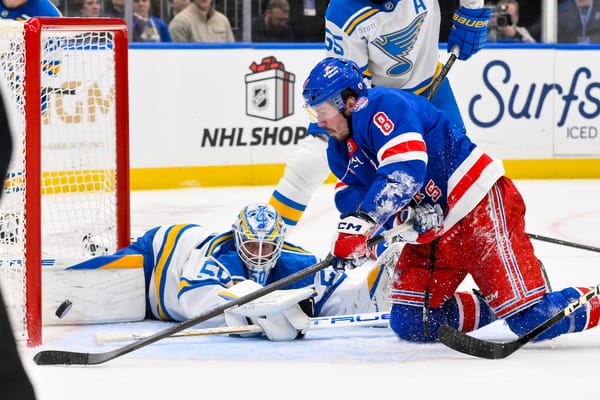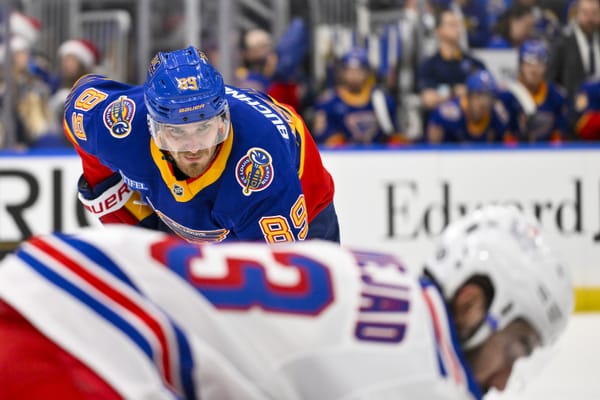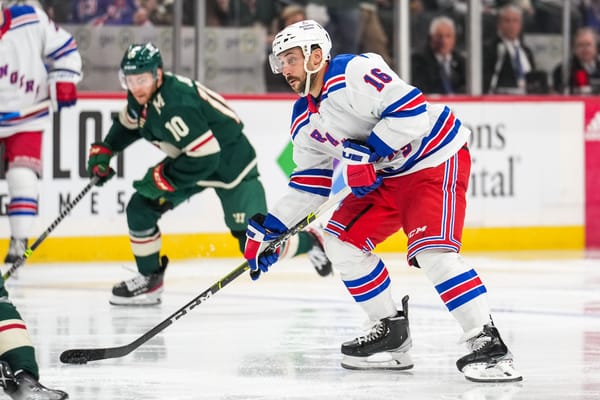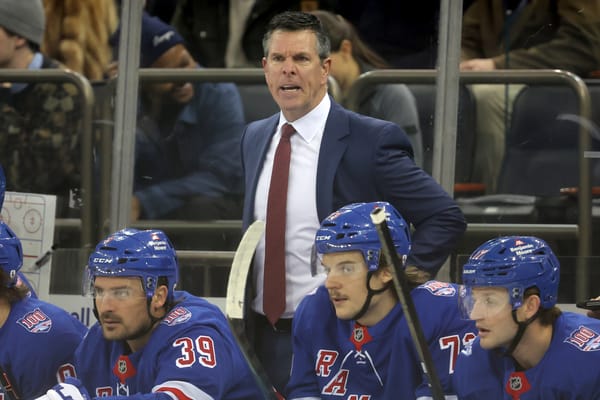Breaking Down How Jeff Gorton Blew It Up
Before the New York Rangers made drastic changes at the trade deadline, before they announced to their fans their intentions to rebuild, and when there was still a sense that they might not do it at all, I wrote the following about our own speculation that Ryan McDonagh might get moved:
This has the feeling of a true turning point for the trajectory of the franchise, and a watershed opportunity and moment for general manager Jeff Gorton. This is without a doubt, the most important situation Gorton has (and perhaps ever may) navigate the organization through. A success here could be a masterstroke that turns the tide of the Rangers’ lack of elite forwards and prospects, setting the team up for competitive hockey for years to come (even if you need to be a little patient for it). A mistake could plunge the Rangers into the lingering darkness that comes from losing their best defenseman without getting a proper return for him. There really is no gray here, it’s all black and white.
That was just in regards to a McDonagh trade, but knowing what we do now, it could easily fit as a preview of what was to come for the Rangers as a whole. The Rangers did a lot of work at the deadline, and it’s hard to view it all in one big picture, but I’m going to try to do it anyway because I’m that kind of guy.
Here we go!
Blowing the whole damn thing to the moon
The Rangers brought the house down. They took the core that propelled this team to a 2014 Stanley Cup run and tossed most of it out the window. This is not some re-tool on the fly, or a change of scenery, this is Jeff Gorton bringing flaming balls of reckoning from the sky.
And you might laugh at that comparison, but in a way it’s very fitting. The charred remains of the Rangers’ 2014 Cup run and an era of success we haven’t seen in decades is the bill for all the failed risks, asset mismanagement, and refusal to see what the team really was. If you’re sitting in the remains of the past, with soot on your face and burns on your hands as you sift through the rubble, remember that this could have been avoided. If even two years ago the Rangers realized they were walking down a very dangerous path, some of this — if not most of this — could have been avoided.
But it took physically hitting the iceberg to course-correct, and now we’re left with a sinking ship. Unlike the Titanic, though, Gorton got a lot of lifeboats (assets) back to work with. The Rangers are very much so a blank slate right now, which brings me to my next review:
Organizational Flexibility
The Rangers have a grand total of seven players on their roster with contracts that don’t expire this summer or next summer (eight if we count Matt Belesky). Ryan Spooner, Kevin Hayes, Vladislav Namestnikov, Jimmy Vesey, and Brady Skjei highlight the group of pending restricted free agents that the team will likely want to negotiate with. Pavel Buchnevich, Anthony DeAngelo and Neal Pionk are RFAs whose contracts expire next summer. Mats Zuccarello is an unrestricted free agent next summer, although I have a feeling his fate will be decided before then.
After this season, Chris Kreider has two years remaining at $4.625-million per, Mika Zibanejad has four years remaining at $5.35-million per, and Jesper Fast has two years remaining at $1.85-million per. On defense, Kevin Shattenkirk has three years left at $6.65-million per, Marc Staal has three years left at $5.7-million per, and Brendan Smith has three years left at $4.35-million per. And in net, Henrik Lundqvist has three years left at $8.5-million per.
A focus on skating ability
The Rangers, in the past, have prioritized size and toughness when it comes to draft picks — with Dylan McIlrath’s selection being the biggest example of that kind of mistake. In the past few years, the Rangers have deviated from this strategy and put a focus on the ability for prospects to skate. Even Ryan Lindgren — who is one big, tough defenseman — can skate and has hockey smarts. It’s no longer the priority for guys to be just big and strong, and that’s a welcomed change.
The other reason for optimism is Lindgren’s skating ability. Typically, “shutdown defensemen” who don’t produce points are the usual slow, clumsy players who belong in 1988. They become exposed as glorified tree stumps in the NHL. Lindgren, though, is a great skater. He seals gaps quickly and can keep up with the fastest wingers. In theory, the right coaches could work with him on joining the rush.
Every prospect the Rangers received during this selloff prospect is, at the very least, a capable skater. That goes a long way toward the style of play the Rangers emulate right now, and will probably continue to embody with a new head coach. In today’s NHL being able to skate is a big part of the game, especially on defense. And since the Rangers added all but one defensive prospects, they’re...
Re-stocking the defensive pipeline
I think it was something of a wake up call when Ryan Graves never even got a sniff of the Rangers’ lineup, even when they were burning things to the ground. Graves may have been a classic case of player being overvalued by fans, which isn’t unusual, but his lack of selection was interesting since he’s only a year removed from an AHL All-Star Game showing. Yesterday, the Rangers moved him in a classic “change of scenery” move with Colorado.
Even though the Rangers helped replenish their pipeline by bringing in Neal Pionk this past summer from the NCAA ranks as a free agent, if Graves was viewed poorly by management, then its clear why they wanted to step things up.
So it makes sense that the Rangers acquired three defensive prospects in Lindgren, Yegor Rykov, and Libor Hajek. Of the three, Hajek seems to have the highest ceiling, but Rykov is one to watch; he’s playing steady minutes for the best team in the KHL as a 20-year-old, and hasn’t been given any real power play or top-tier offensive opportunities. The MO on all of them is the same: very good in their own zone, with skating abilities (as seen above).
None of the players are elite-level prospects, and the order I named them above seems to be the order they’re valued around the league (from worst to best). Some believe Hajek belongs in the second tier of prospects (i.e. not elite but very good), and Rykov is a solid prospect himself. Lindgren had more pedigree than either at the time of his draft, but has kind of fell off the map since then. That said, he’s not a bad prospect at all, and all of these prospects are better than what the Rangers had in their system (not counting DeAngelo).
The re-stocked defensive corps now makes this June very interesting. The Rangers have three first round picks, two second round picks, and two third round picks. Will they focus on wingers because they scouted the draft and don’t like many defenseman? Was this just a coincidence with Gorton getting back the best prospect he could from each team? That remains to be seen.
The Rangers have to swing for the fences in June
Like I said above, the Rangers have seven draft picks the first three rounds. Seven. That’s a lot! A conservative breakdown on where the picks will fall is as follows:
1st (NYR) 3-7th overall
1st (BOS) 25th overall
1st (TB) 31st overall
2nd (NYR) 34th-38th overall
2nd (NJ) 45th-50th overall
3rd (NYR) 65th-68th overall
3rd (BOS) 85th-90th
I haven’t dug deep enough into the draft, but some people have, like Steve’s preview below:
Quick NYR 2018 mock draft:
— Steve Kournianos (@TheDraftAnalyst) February 27, 2018
1st/7th (NYR): RW Oliver Wahlstrom
1st/26th (BOS): LW Dominik Bokk
1st/31st (TB): RW Grigory Denisenko
2nd/38th (NYR): LHD Johnny Tychonick
2nd/45th (NJD): RHD Filip Johansson
3rd/69th (NYR): RW/C Jonatan Berggren
3rd/88th (BOS): C Ivan Morozov
Last year was the first time the Rangers held a first round pick since 2012 (where they drafted Skjei), so it made sense for the Rangers to go conservative with one of the picks — which they did when they took Lias Andersson 7th overall. You can make the argument they should have went safe with the 21st overall pick (where they took Filip Chytil), as I did this summer here:
Now, it’s not the biggest deal in the world to reach a few picks for a guy you really like. But in a draft where it seemed like moving down was preferable to moving up, and with the Rangers being devoid of a second and third round pick this year? Yeah, moving from 7th to 14th or 15th in order to earn an extra second round pick might have been smarter.
Right after his selection, however, it was rumored the Los Angeles Kings (sitting at 11) were hot and heavy for Andersson, and the Rangers obviously weren’t sure they’d be able to fall back and still have him around, so they grabbed him at 7th.
I can tell you with relative certainty that the first round played out in a way that led to this move. The Rangers were very interested in Elias Pettersson, but he was taken 6th by Vancouver. Cale Makar was one of their highest rated defenseman and he was taken 4th overall. When your top of the card players are being selected, it changes the strategy a little.
All that said, Andersson is not an elite-level prospect — even though he’s putting up an unexpected amount of points in the AHL this year. Chytil has the potential to be an elite-level player, but not generational (as Adam said, not a Sidney Crosy, but if everything breaks right maybe a Claude Giroux).
Defensible as last year was, that cannot be the strategy this year. The Rangers will most likely drop into the top-five in the draft this summer, but even if they don’t, there’s elite talent through the first six or seven names on the board; they need to draft one with their first-round pick.
From there, the Rangers need to be targeting best player available, even if that means a boom-or-bust selection. There is high-end talent available late in the first, of course, but it’s also there to be had in the second and third rounds. There are players who drop because of their (lack of) size, or the Russia Factor, or attitude, or whatever; clear red flags should obviously be avoided, but outside of those, they need to swing for the fences.
With five picks in the first two rounds, you need to get back at least one impact player (with the top-seven pick). You also need to walk away with at least two “B-level” prospects. This is all subjective to the time, of course, since drafting isn’t an exact science, but the Rangers nevertheless need to be grabbing the best players possible. If they prefer to play it safe, they need to do that after their first-round pick. Again, there’s no way to see if this strategy works until a few years down the road, but at the time of the selection, the moves have to be big swinging moves. You can at the very least make that call at the time of the draft.
Gorton sold at the right time
There’s something to be said for the way Gorton handled himself this deadline. He moved Holden, Nash, and Grabner all before the final day, which netted the Rangers better returns than they would have gotten otherwise. He navigated through the near-impossible waters of moving Ryan McDonagh while the same teams were looking at Erik Karlsson. A lot of people lamented that Gorton could have gotten more if he would have just waited — something I combated on twitter — but the proof ended up being in the pudding.
Yes, there are years where the final hours of the deadline are crazy. When there are way more buyers than sellers, prices are being driven through the roof, and teams overpay so they don’t miss out. But this wasn’t one of those years, nor did it forecast to be.
As a perfect example, Evander Kane, who is just 26, got back a 1st round pick and a prospect. Compare that to Nash getting a 1st, a prospect, Ryan Spooner, Matt Belesky (50% retained), and a 2019 7th round pick. Sure, there were salary ramifications to Nash’s deal, but the apples to apples shows the Rangers walking away with much more.
That’s timing. Gorton knew the market was likely collapsing, and he hit it when he had the shot and got the best returns possible. Yes, the Rangers sold more than any other team did, but they got back significant value on every trade made (compared to who they were giving up). If you want to be underwhelmed by the McDonagh/J.T. Miller return, fine, but the whole package of work from Gorton this week was fantastic.
Alain Vigneault’s expiration date is nigh
This is the end of the Vigneault saga, or at least it needs to be. The Rangers have seen enough from him to know that developing youth isn’t one of his strengths, and that’s the direction the Rangers have now aligned the ship.
Vigneault succeeded in New York (and Vancouver) with veteran-filled teams that had defined roles, limited youth, and a room that was already aligned with the veterans who were in it. In 2014 the leaders were Brad Richards, Martin St. Louis, Rick Nash, Dan Girardi, Brian Boyle, Dom Moore, and eventually Dan Carcillo. From that summer on, though, the team started turning over to players Vigneault had favor for, and they removed key pieces of the 2014 core to fit them in. Accountability only factored in to players who hadn’t earned Vigneault’s trust; youthful players who were offense-first were buried or put in roles that didn’t suit them, all while ageing veterans held positions on the wall they could no longer defend.
It cost the Rangers with a 2016 first round blowout in Pittsburgh, then again last year when the team had a golden road to the Eastern Conference Final. Vigneault is a man who simply adjusts back and forth from his own ideals, never blames himself, and hasn’t made a major adjustment to his thinking since he came to the team in 2014. That’s not a guy the Rangers want, need, or should have behind the bench as they go through this transition.
We’ll review options for his replacement once he’s fired or as the season dies, but the Rangers need to know this is the end.
There’s more to come in June
This post is already over 2,400 words, but I’m going to add a few more. Maybe a lot more.
The Rangers aren’t done. In his press conference Monday afternoon, Gorton joked how the Rangers’ phone rang a lot more on draft night last year because they had two first round picks. Now they have three. I would be shocked if the Rangers didn’t make a move on the floor, especially since they have seven picks the first three rounds.
Do they prioritize getting a pick or two for 2019 — which is supposed to be a loaded draft? Do they want to move a top pick for a young roster player who can help them right now? Are one (or both) of those things going to get taken care of with a Zuccarello/Ryan Spooner/Vladislav Namestnikov move? I’m not sure. I expect Zuccarello to be moved draft day, and I do think the Rangers are going to entertain talks on the high-end picks they do have.
What materializes from any of that remains to be seen. The forward group could get additions of Nash/Ilya Kovalchuk and be relatively decent next year, but the defense is an abomination that’s not going to get any better unless the Rangers get some help there. They might be okay with that — with the plan being to tank again in 2019 for another top-pick — but that also remains to be seen.
After this trade deadline, there are still a number of options for the Rangers moving forward. We’ll have a better idea of what that direction is in June. But there are certainly moves to come, and probably a lot of them.





